Binge-Worthy Product Career Hacks by fmr Netflix VP of Product

Whatever stage of your career you’re in, it’s never too late to start career hacking. In this episode, speaker, author, and former Netflix VP of Product Gibson Biddle talks about how to treat your career like a product to: 1) find out how you can add value for your employers, 2) uncover what kind of career will bring you fulfillment, and 3) create a feedback system so you can keep on getting better and better.

Editor’s note: The following has been edited for readability. You can find the slides for this presentation here.
I’m excited to be with you today to talk about hacking your Product Leader career. I’d like you to start by thinking about the most important product and that product is in fact, you. I want you thinking about yourself as a product.
When you go into a grocery store, you see all these cereal boxes on the shelf. Think about your experience such that you’re one of those sold-out cereals. Thinking about yourself as the product is the key concept in hacking your Product Leader career.
We’re used to building products, and building products, we form hypotheses, and then we find ways to experiment with those ideas. And then we have results and feedback systems to figure out what’s good or bad. I encourage Product Leaders to take the same approach.
So my background: my name is Gibson Biddle. I started early at Electronic Arts, and then I built kids’ software, including Sesame Street. And then I joined Netflix in 2005 and then moved on to my next startup Chegg, like, “which came first, the chicken or the egg.” That was in 2010. It’s a textbook rental and a homework help online Chegg study program.
And then the last three or four years I’ve been doing this kind of stuff. Now I’m very focused on talks, workshops and writing for Product Leaders. Today’s talk, it’s really around three different chapters, if you will. The first is how do you position yourself? The second is how do you experiment—or I call it career hacking. And then the third is about having results and feedback systems because none of us are self-aware. So how do you form this thing that I call a personal board of director?
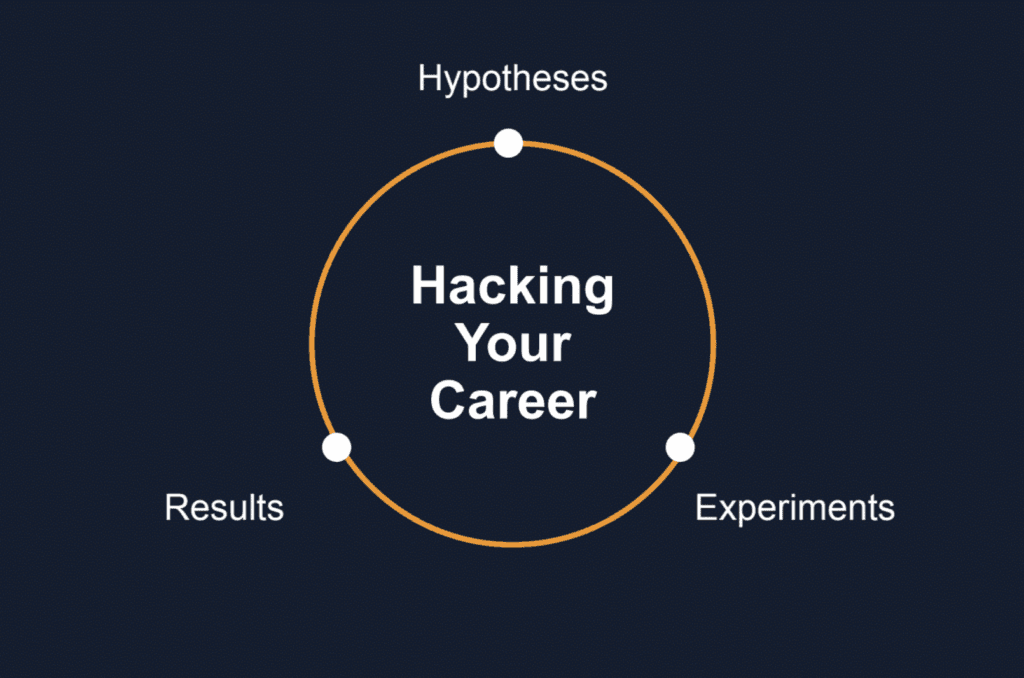
Let’s move on to Chapter One: Positioning Yourself. I want to talk about the skills that you need and that you’ll develop over time to progress into a leader. I have a very simple positioning model. It really asks three questions. And I want you thinking about, how would you answer these three questions for yourself? The first question is What is it? What are you? The second question is, what are the benefits that you provide to an employer? And the third is, what is your personality? And that’s because all products need to be relatable to its customer.
I’ll answer the question for me. Gibson Biddle is a Product Leader Executive who helps startups with a proof of concept to scale. And then to reveal my skills, I have strong strategic thinking, management, and leadership skills. And then to reveal my personality. If you know me, I try to be genuine and I do it in a sometimes quirky way, a little bit weird at times.
So that’s me. And the real question is, how do you position yourself? And I want to give you some deeper thinking about how I arrived at some of the solutions for me. The first question I pose of Product Leaders is, what are the skills in order to be a successful Product Leader? Now I’ve asked these questions of thousands of Product Leaders. Recently I did it with many hundreds of Product School peeps.

When I asked them the question, these were the answers, I built a word cloud for you, and you can see that key is communication. And then you see a notion of vision, and visionary, and storyteller. You see strategy, the ability to inspire, empathy, all of these things, and these are all components of it.
When I’m answering the question, “what are the skills of a Product Leader?,” I sort of define it in two sides. The left side, these are the product skills. And then on the right, no matter what function you’re in the aspiration is to grow into a leader. I have very specific leadership skills as well. If I’m interviewing a candidate, these are the seven words that I’ll stick on a whiteboard and I’ll ask the question, “Hey, what are your top one or two skills on this?” And I’m not searching for anything. I’m just trying to get to know that person’s various skills. But if I talk to a candidate, they’ll say, “well, what do you mean by each of these words?”
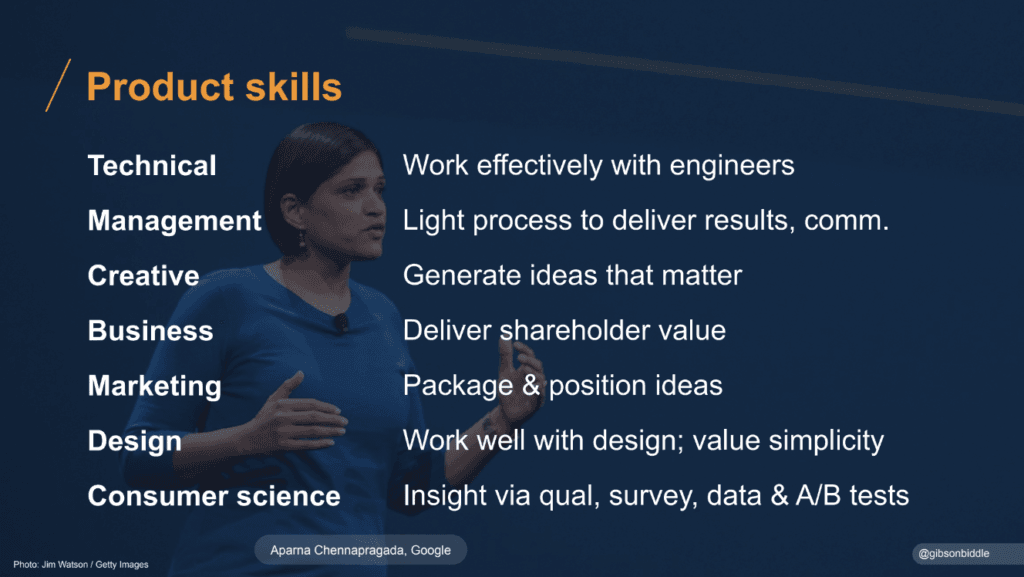
I’ll share it with you. By technical I mean, you work effectively with engineers. You don’t let your eyes gloss over when the conversation gets too technical. Management, my definition is: light process to deliver results. And this is where that important word communication lives. You can bring people together to build stuff. That’s really what it means.
We’re in a creative industry and our job is to generate ideas that matter. And then it’s helpful to build a business. If we generate profits or shareholder value, then we are able to invest more money in building an even better product in the future. And then you can tell, I think marketing skills are important for a Product Leader. You have the ability to package and position ideas, make them relevant. So customers know that they’re for them and they choose to buy them or use them.
In the last 15 years or so, when work went to these teeny devices, it got important that you work very well with designers and that you value simplicity. It takes a lot of discipline to work on that tiny screen. And then, I call it consumer science. It’s been the big deal in the last 10 or 15 years. It’s all about developing consumer insight. This is where that word empathy lives. You get inside the heads of your customers via qualitative focus groups or usability. Through survey, by asking them what they think, by digging in the dirt with existing data to look through for hypotheses. And then the big dog is AB tests. You do this and this and which one’s better as looked at through metrics, which changes customer behavior in ways that helps you.
So on the other side of the ledger, the leadership skills. It’s the same exercise, seven words on a screen.
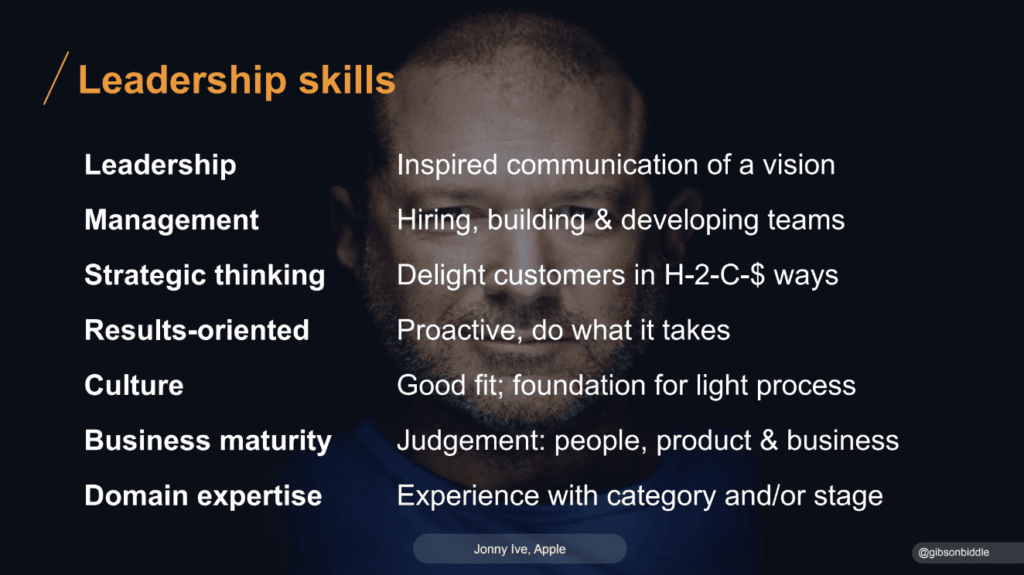
And the question is, “what are your top one or two or three skills on this list?” Leadership. My definition is, “inspired communication of a vision.” That’s where that vision and visionary part fits in.
Then as you grow up as a leader, and by the way, I know that many of you could be early in your career, but I want everyone to behave like a leader and begin practicing leadership skills early. What I mean by management is over time, you’re hiring, building, and developing teams.
And then strategic thinking. The context of product is you develop hypotheses. These are product strategies, as ways to delight customers in these hard to copy, margin-enhancing ways, ways to make money. As a leader, you’re not a follower. You need to be proactive, results-oriented, do what it takes to make stuff happen.
Then there’s a softer side to a leader. That’s where it’s all about culture. I love culture because if everybody in a company understands the values of a company, they can make great decisions without talking to each other. You don’t need any process. So it helps evaluate fit, but it’s also a foundation for light process. And business maturity just means you have great judgment around people, product and the business. Sometimes it’s correlated with age and sometimes not. And then domain expertise. Different companies need different things depending on their category and the stage of the company.
So these are the seven leadership skills that I look for.
Just to give you a sense of how different folks are, this is April Underwood. Until about a year ago, she was the Product Leader at Slack. I’m sure most of you are using her product probably right now. I asked her, “Hey, April, on that left-hand side, what are your key skills, your superpowers?”

And she said, “Hey, I’m very strong technically, I grew up as an engineer. I have strong business skills. And like you, I understand the importance of marketing and I’m strong at it.” And then on the other side of the ledger, her leadership skills, she says, “I’m very strong on strategy. I’m highly proactive and results-oriented. That’s why I work with earlier-stage startups. And then I think I have great judgment on people, product and the business.”
To understand me: business, marketing, and consumer science for product skills. And for leadership skills: leadership, management, and strategy. The point is, we’re all different. It’s about finding the best fit role for us at the company that’s looking for certain skills.
Those are your superpowers. I learned to really focus on my superpowers, not worry as much about some obvious deficiencies. People hire you for those really strong things that you do. This is what I want you to think about. What are the two or three words on the left that define you? Your superpowers. And in the top two or three words on the right.
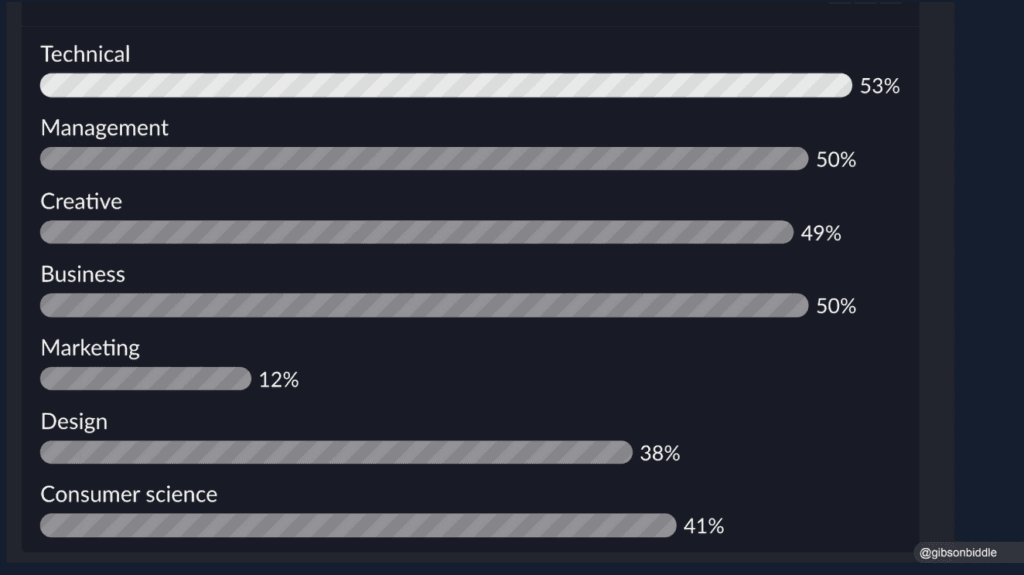
I’ve asked this question of thousands and recently with the Product School audience. When I put these seven words, you see a rich diversity. None of us are the same. In that audience, strong on technical. But you can see a management, creative, business are tightly bundled. And then not a huge surprise to me, not many folks self-identified as having strong marketing skills.

Moving on to the second question on the right side of the ledger about leadership. This one actually has a little bit more diversity. You see people self-identifying on culture. And you see the leadership and the strategy are strong. And then it may be, a lack of confidence around the business maturity, or simply youth. News flash, as I got older, I didn’t necessarily develop better judgment.
There’s a real range of the skills that people say they have. And the good news here, you don’t have to learn all these skills overnight. You have time. In fact, you develop them as your career progresses. So this is what I call a career ladder. You start at the bottom and you work your way up. So I’ll share it in my career.
The first thing I ever built, the question was, could I build something? Could I get engineers and animators and designers together? Yes, I could. And built Sesame Street, Counting Café. Spent $300,000 and sold 300 units. So, not a hit.

My first hit product was Sesame Street, Elmo’s Preschool. A full preschool curriculum in a box for two, three, and four-year-olds. And then over time, I built lots of kids’ software, but I realized that my job was really to help build a successful organization where others could do that kind of work. So I had a Product Leader on Madeline, a little French girl, on Schoolhouse Rock, on Arthur.
I had a team, I was building an organization and at some point, I became a VP of Product. I realized that a big part of the job was now to build successful companies. And see, these are the four that I had a hand in.
The reason I went to Netflix…I aspired to do more. I wanted to help build an industry. And that industry, in fact, is streaming. I’m guessing that most of you were streaming last night, or maybe some of you are streaming right now on the side. Stop that! Focus, focus!
Anyways. This is what career ladders look like, and you develop different skills at different moments in time. Early on when you’re trying to build something, it’s basic design and management. Can you pull together teams to build a product? The next stage for me, with Elmo’s Preschool, you can tell, I was aware of the packaging and the positioning, the marketing, and then consumer insight, getting the inside the heads of two, three and four-year-olds. And more importantly, their parents who buy stuff.
As a VP you start learning how important leadership is. That inspired communication of a vision, strategy, hiring. Then you begin to understand why culture’s so important. Now imagine you’re a VP of Product. If you’re building a company, your job is to build alignment with your marketing partner and your CFO, and your sales partner. You begin to understand why strategy is so important.
And if you have the good fortune to be engaged in building an industry, it’s all about long-term strategy. Think about the hundreds of partnerships that Netflix established in order to enable you to watch anytime and anywhere on any TV-connected device. That was there because of long-term strategic thinking that worked, as well as partnerships. Netflix did not go it alone, it never built one box.
The question I pose for audiences, and again, I’ve done this with hundreds of Product School peeps—what stage are you engaged in today? I let people sometimes answer two if they’re in the middle, I let them answer the one below and one a notch up. But you can see there are lots of folks that are engaged in building their first hit. And then I’m actually delighted that 7% of the audience had the pleasure to engage in building a new industry. So if you can see how it maps to most of the Product Leaders out there today.
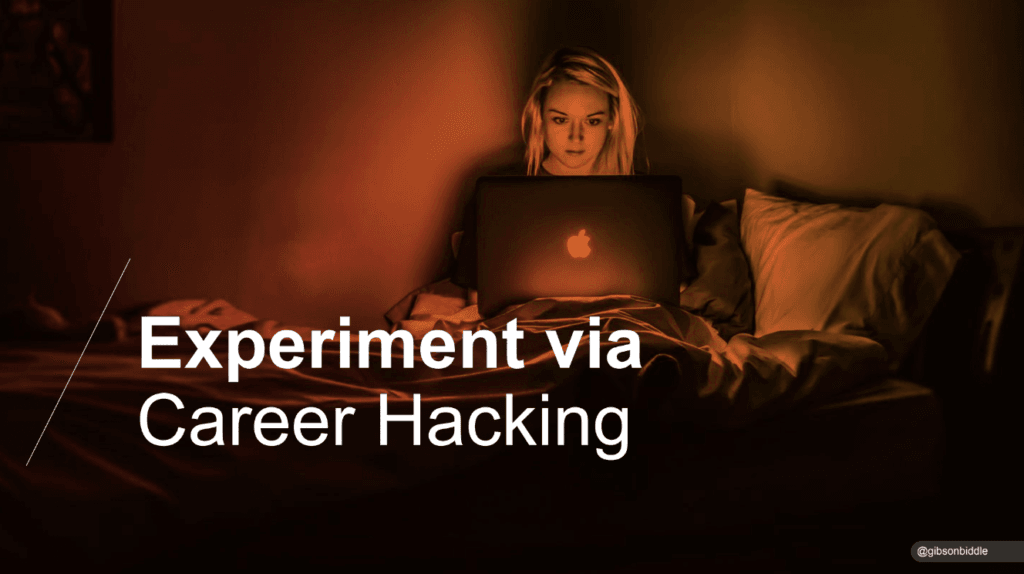
I’m coming on to Chapter Two, and this is about that experimental approach to careers. That’s what I call career hacking. And I have to reveal a little bit about my career to give you some context. Careers are not linear. You don’t just go down the railroad tracks. They are a meandering path. I have been thrown off the railroad tracks. I’ve been hired, I’ve been fired, I’ve laid up, been laid off, I’ve run out of money, all of these things. And that actually happens a lot.
LinkedIn, for instance, has all of our data. They know that careers are a long and winding path. They look for, what’s the path that an entry-level person takes to get to CEO? And the reality is they join customer support and they slide over into sales and then maybe into marketing, maybe into financing, maybe back to product. And eventually, they end up as the CEO. That’s what careers really look like. And in that case, that CEO is building all the skills that they need, including the cross-functional alignment, they’re very effective at working with folks in different functions.
I love Google. When I did a Google search for fork in the road, this is what I got. That delights me. But I use this image to share with you the idea of career hypotheses, these forks on the road.

Early in my career, these were my key questions: did I want to be in marketing or product? Did I want to be a starter—join right at the beginning of a company—or something that had progressed as a builder? Did I want to be in consumer or enterprise? Did I want to be an entertainment or education? These were my high-level career hypotheses, and I was finding a variety of ways to answer these questions over time. In fact, over a very long time. To understand my career, I took a year off from college and I ran a sailing school with some pals.
I came from Boston to the San Francisco bay, which I loved. And then I graduated from school. I continued with J World, but then I was afraid that I was going to turn into a beach bum, so I began my professional career in a creative industry. At an ad agency. And I worked in the mailroom my first six months.
And then I grew up as a marketer, and then I was in Silicon Valley and I wanted to learn a lot of other skills outside marketing. So I made the commitment to spend two years at business school. This is at Tuck, which is Dartmouth. And I chose it because it’s the only place that has its own ski area. This is me with Kristen, we’re now married, and those fashions are coming back. Gosh, darn it.
At two in the morning, after I’d finished my homework at business school and my cases, I would stay up late and I would hack. I was building prototypes for kids’ educational games, using HyperCard, which is one of the first object-oriented programming languages.
And then that summer I had a summer job at IBM in market intelligence. I was there really researching, trying to figure out where I would go after I graduated. I had the confidence that Electronic Arts was going to grow into a big company, which happened. Then I got enamored of getting back to kids and helping folks learn.
That’s when I signed a long-term exclusive to Sesame Street and built lots of Sesame Street software. Then eventually that startup, we sold it to this gentleman. This is Kevin O’Leary, you know him as Mr. Wonderful on Shark Tank. He was the CEO of the learning company. We helped that company to grow and we sold it to Mattel. And now we enter the dot-com era. Family Wonder.com, this is a startup that we did. If you were looking for something fun to do with your kids, or to buy, you’d visit this site. But look carefully at the pixelation in the logo. You know, that that company died.
Okay. That was a failure. And then my next startup, I was trying to help via neuro performance improve the lives of people with dyslexia. So they could read better, faster and more easily, and look very carefully at this design. You’ll realize, oh, this did not work. Okay. So those are two failures.
You can see in my LinkedIn profile at the top it’s VP Product and below it’s VP Product, but there’s this thing in the middle, which is consultant. And I’ve just papered over three years of failure. That’s what real careers look like. But I developed the grit and the persistence during that time, I would dust myself off and try the next thing. When I was low, I would take care of myself like going on runs or biking or volunteering at kid schools, whatever sort of gave me a little bit of sustenance to press on.
Obviously, things worked out. I joined Netflix and then I went to Chegg because I wanted to help take an educational technology company in public. I’m passionate about education. You can see me on the left. I got the orange hat. I refused to buy a suit. And news flash, I wasn’t very happy. And I’ll reveal why I was unhappy a little bit later.
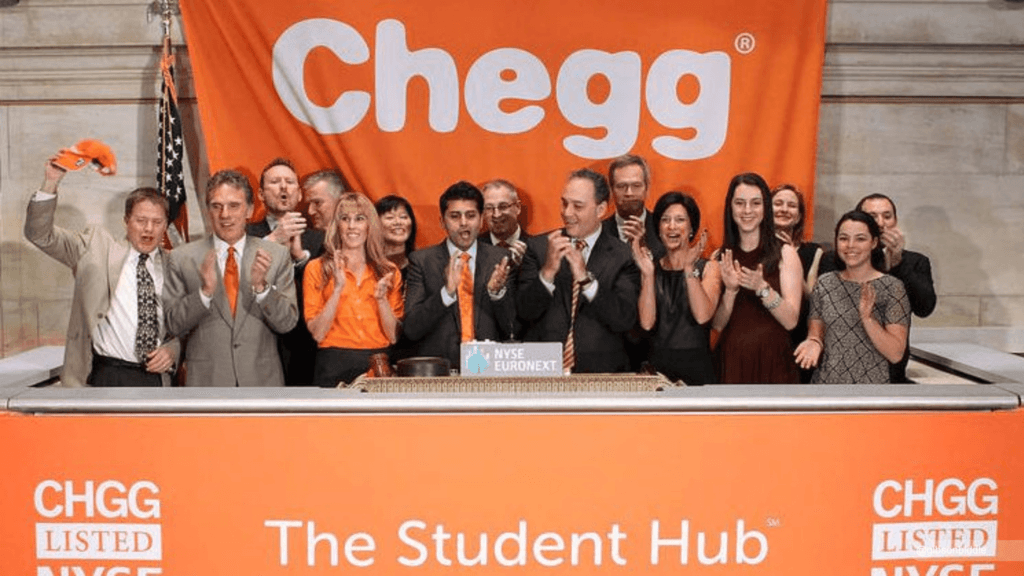
So I’ve just taken you on a career. That’s 25 or 30 years. That’s a long time, but I was able to answer those hypotheses. I’m way into product. I don’t think of myself as a starter from scratch. I’m actually a builder. I look for startups with proof of concept, ready to scale and then help ’em to grow. And I love consumer. Then it turns out the answer to education versus entertainment is both. Entertainment tends to pay a little bit better. And I like education because you have a chance to really improve people’s lives.
So what I want you thinking about right now, is what are your career hypotheses? That’s what I want you thinking about. What are your forks on the road? What are the things that you’re interested and passionate about? What do you do at two in the morning that’s not binge-watching on Netflix? And what are potential new functions or roles, all new jobs that you might like to take on within your company or at different companies.
I want you in doing this to think long-term because in the long term, anything is possible. And we tend to focus on the day-to-day and the week-to-week, month-to-month. And occasionally just back up and say in the long term, maybe five or 10 years from now, what would I like to be doing?
What are the small hypotheses or experiments that I might pursue in the short term to see if that’s the right place to go in the long term? If you’re into hacking, it’s all about fast-paced experimentation, and you need a metric. The real question here is: for a career, what’s the right metric?
Again, I put this out to hundreds of Product School people, Product Leaders, and I built a word cloud based on their results. And you see happiness in the middle. The way I think about it is job satisfaction. You can see impact, you can see money. What I did was I graphed out all three of those things over my career to see if it gives us any insight into what metric is helpful in making these career decisions.
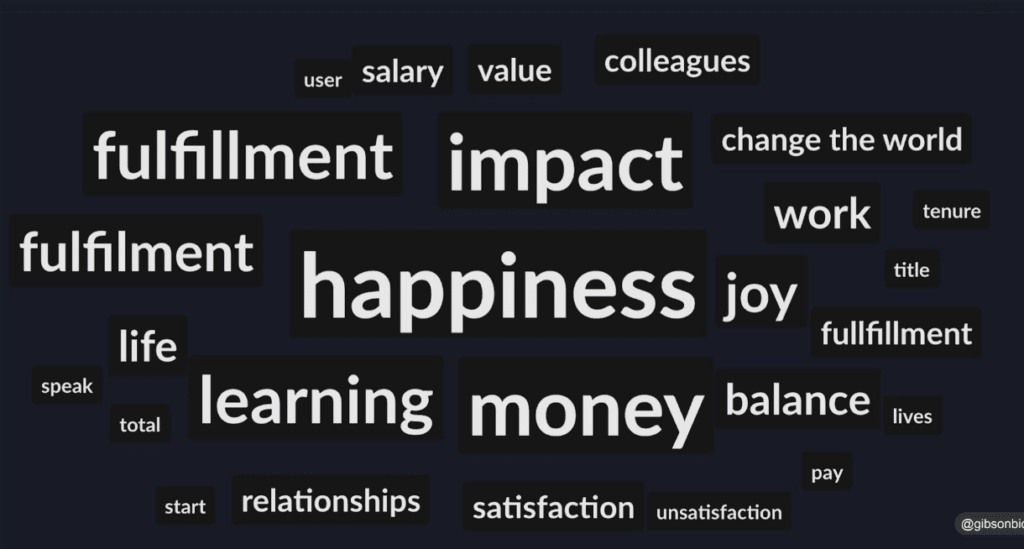
So here’s income look to the left—J World Sailing School doesn’t pay well. You can see that that valley of death where I had two failed startups in a row, but then you can see, I actually joined Netflix and I really wasn’t penalized things went way up into the right. And then I stopped at Netflix, dropped down at Chegg and then went up into the right and I stopped and I’ve been doing my career hacking and it’s going up into the right again.
This is the question that I found really helpful. On a scale of zero to 10, where zero sucks and 10 is awesome, how satisfied are you in your current role? And that’s the green line. You can see it goes up and down, but look for a moment over the red N in Netflix. And you can see, I was unhappy and then I joined there, I got happy fast, but notice it started to drop off over time.
And there were a couple things. I wasn’t learning as fast, but also there was a recognition as a builder. You know, I was the right guy for a period of time. But the skills were wrong for the next stage of the company. I had taken his statistics course at business school and that was good enough, but they needed a consumer scientist in my role that probably had a PhD in statistics to do all the machine learning. This is when I started looking around and thinking what’s next. And obviously Chegg was a good outcome.
This is a hard one. My wife is physician-scientist, so she’s literally trying to cure cancer. And she holds me to a higher standard. I let her evaluate the extent to which these different jobs were good for the world. You can see over Kevin O’Leary and Family Wonder like, you’re doing good for education.
Then Netflix, she’s a little tough on me. Like, okay, how much does binge-watching really help, Gib? And then Chegg. Chegg has managed to help students save billions of dollars renting instead of buying. And she’s very praiseworthy of the stuff that I’m doing now as a teacher/workshop host/speaker.
Oh, by the way, you know, I didn’t really highlight what happened with Chegg. The reason I was unhappy, you can see my job sat was high around Chegg and then it dropped. And the reason was I was frustrated by the slow rate of change in the education category. That’s what caused me to engage in the kind of stuff that I do today. Much more flexible, much faster.

Okay. So here’s the key insight that I’ve discovered: it’s all about that job satisfaction. And really what I want for everybody is that they have a job sat that’s eight, nine or 10. And if you’re in that place, one of those people, that 25% that were zero-six, and you’ve been there for three, six or nine months. It’s not just a bad day. This is persistent. I really want you to start thinking about those hypotheses, those experiments about what might be next for you, because I think change will be good for you.
This is all about the job sat. I’ve asked this same question, what’s your current job satisfaction. And here’s the answer. 40% at zero to six. That makes me so sad. And then the nine or 10, that’s just delighted. Those people was super happy. And frankly, I feel pretty good about that 35% who are at seven or eight. And this has really been the most helpful proxy metric that I have found in navigating careers.
So some notes on career hacking after doing it for many, many decades. My first note is be bold. If you take a long term perspective, you know, it’s about being courageous as I did to switch from marketing into product, for instance. And it’s about forming these hypotheses and then finding these lightweight ways to experiment with them.
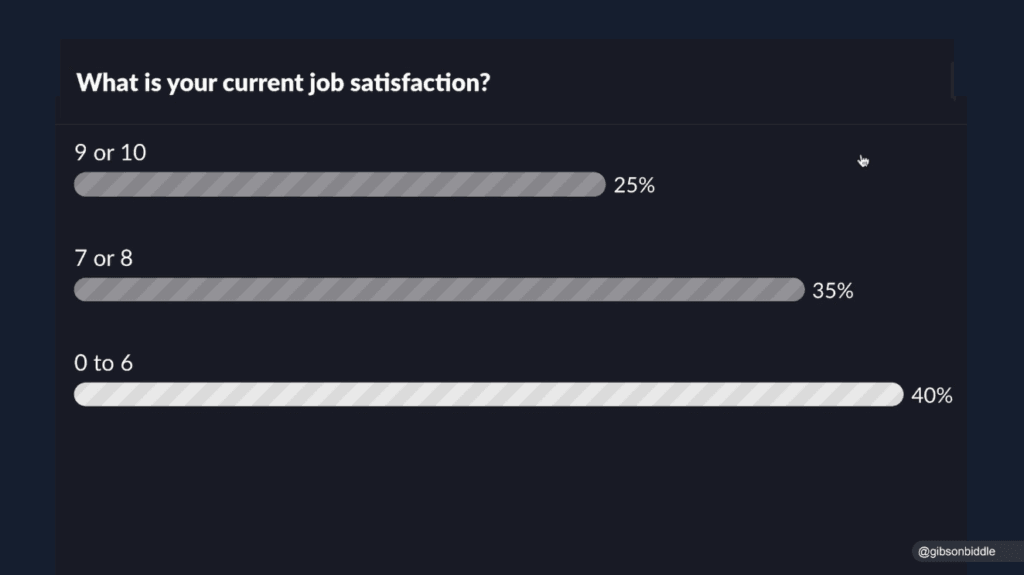
You don’t have to quit your job and start a new one. You can go out to coffee or have a Zoom meeting with somebody. Or you can take an online course. You can do what you’re doing today. Think about that two in the morning test. What is it? Some something you’re so passionate about that maybe you should make it part of your career. And it can’t be binge-watching.
Side projects. What are the light ways? If you stopped watching your 40 hours a month on Netflix, that’s time for other side projects. Or maybe you find a punk startup that you’re interested in and work with them on Saturdays.
Because at the end of the day, companies are looking for people who are passionate about the work that they’re doing and they have intellectual curiosity. They’re really trying to figure this thing out. And that leads to this notion of grit or persistent and all employers are looking for that magical combination of those three elements.
So I told you to be bold. I’ll just give you a few notes on things that I have found helpful in enabling risks. First is education. There are many ways that you can begin to learn about these new areas. And then find ways to have a small success and, and maybe give you the confidence. You could spend more time and energy on that. So my building prototypes at two in the morning gave me the confidence: maybe I could do that in real life.
And then keep your life simple. My wife and I still own the same starter house that we bought in 1993, kept our life simple. That lets us take on financial risk without worrying about mortgages. You can tell one of the side benefits of being thrown off the railroad tracks so many times, I know a lot about job hunting. Or at a higher level, I call it career hunting. I included an article at the end of this talk that I think many of you will find helpful.
So I’m bringing it into our third chapter today. We’ve talked about how you position yourself, how you can take this career hacking experimental method formed by that one job satisfaction metric. And now, because none of us are self-aware, we need to talk about stuff with folks, and we need help evaluating what makes sense or doesn’t.
The thing that I have found incredibly helpful is this notion of a personal board of directors. When I talk to folks about 10% have one and they find it extremely helpful. I’m trying to get the 90% who don’t have this to think about, Hmm, what would it take to form this board of directors?
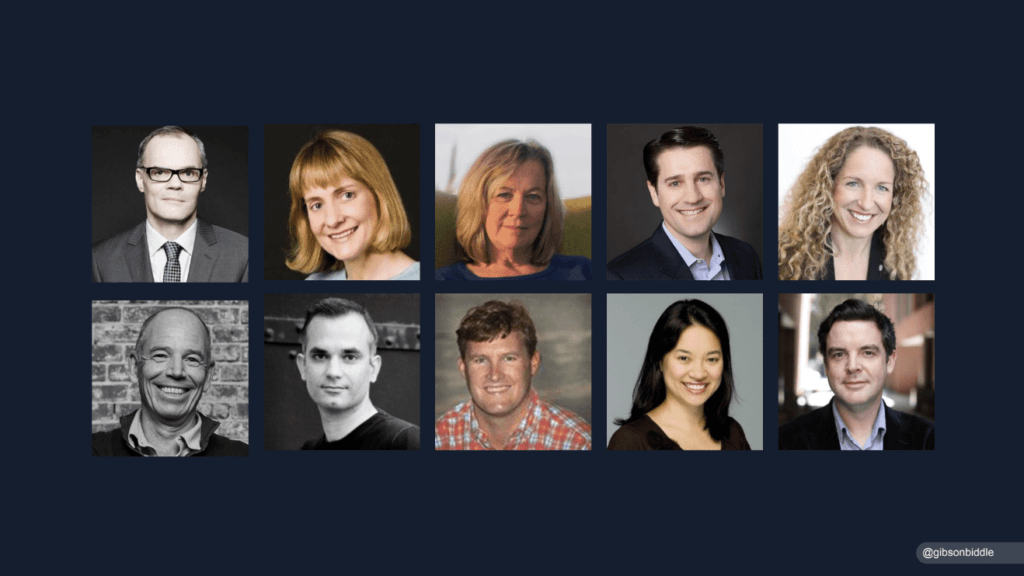
Here’s mine. It changes year after year. In recent past, I’ve gotten some folks who have written books who are speakers, who are teachers who do workshops and they’ve been incredibly helpful to me. I just want to take you back to the genesis of this idea, Greg Bestick, he’s the white-haired gentleman in the middle. He was my CEO when I first became a VP of Product. I said, Greg, I need help learning how to be a better Product Leader.
And he said, sorry, can’t help you. Go out and build relationships with your community of peers. I think you’ll find that helpful. And he was right. So I would have lunch with a few folks at least once a month. We’d talk about the issues of the day. Incredibly helpful to me.
This is Irv Grossbeck. I went to little Amherst college in Western Massachusetts probably got 1600 students. He went there, a generation ahead of me. He invented the cable TV industry. And now he’s a dollar-a-year professor of entrepreneurship at Stanford. And I was having my office hours with him and Irv sort of listened to me. And then he looked at me, he said, “Gib, can I tell you something you may not like?” And I sort of buckled up my seatbelt. And he said, “you’re too nice to be a startup CEO.”
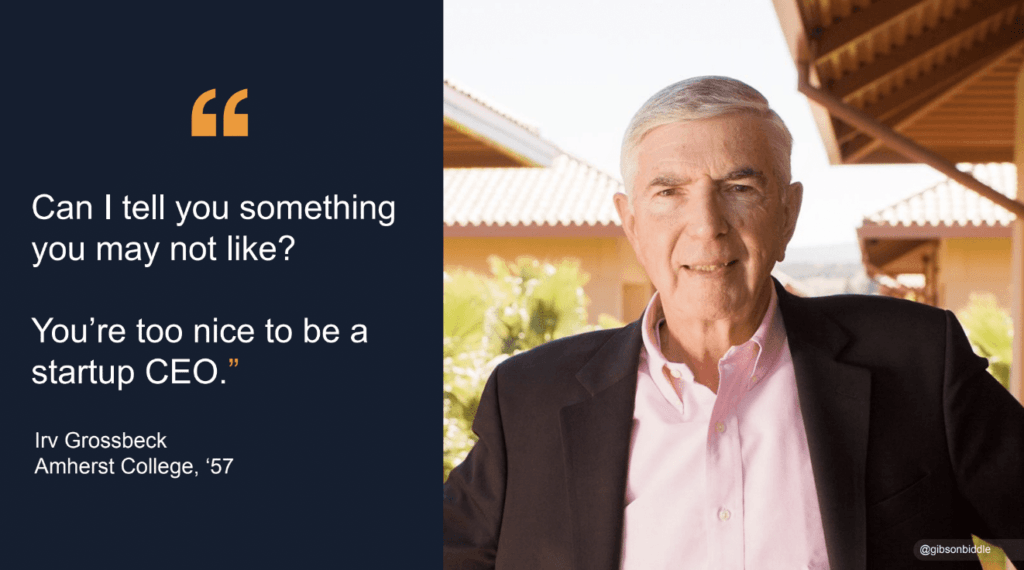
What was going on was my hypothesis was I would go beyond Product Leader to be CEO, to be the head of a company. That was on my mind. By the way, there are some nice CEOs out there. But he said, “Gib you’re very thoughtful. You’re very deliberate. And the most likely path for you to become a CEO is at a startup. And it just doesn’t seem like you, I don’t think you’d enjoy it.”
And that resonated with me. He kept me from probably banging my head on a wall for five years if I had taken on that role. He released me from the notion that I had to do something like that before I die.
Patty McCord, she ran HR and people at Netflix and I had stopped working. I was looking for non-traditional roles and I said, Hey, I’m frustrated. I’m not finding non-traditional roles. This is on a walk on the beach in Santa Cruz. And she said, “Gib, just tell people what you want.”
So when folks started calling me, I said, “Hey, I’m interested in being a Product Leader, but only if it’s three days a week.” And that happened. They would call me an executive in residence, but I was the three day a week Product Leader at Life 360, at Nerd Wallet, at Metro Mile. It was awesome. And this was just based on a conversation walking on the beach.
My wife, Kristen is on the left there. That’s Kelsey and Brett, my daughters. She knows me well. She says, “Hey Gib, for you it’s all about creative pursuit.” In the last few years, she encouraged me to focus on talks, workshops, and writing because she knows how much I’m fueled by the creative process.

So you need a board! Build a board. A couple of notes. Invest in the good times. Okay? People don’t like it if you come to them when you’re struggling. This is a forever thing that you need to do. And you could tell, like with Irv Grossback, I listened very carefully to him. I can still repeat him, you know, 10 years later. And you need to refresh your board often. People age out, they’re no longer relevant. Or in my case, I need to develop new skills around talks and writing and workshops.
I don’t meet with them quarterly, like a board of directors. It’s a little bit casual. Some of the folks I check in with once a year and some of them it’s once a month. If I’m contemplating a big shift, I’ll do a sort of email summary to all of them and say, Hey, what do you think? Whatever cadence works for you to form a relationship where they care about you.
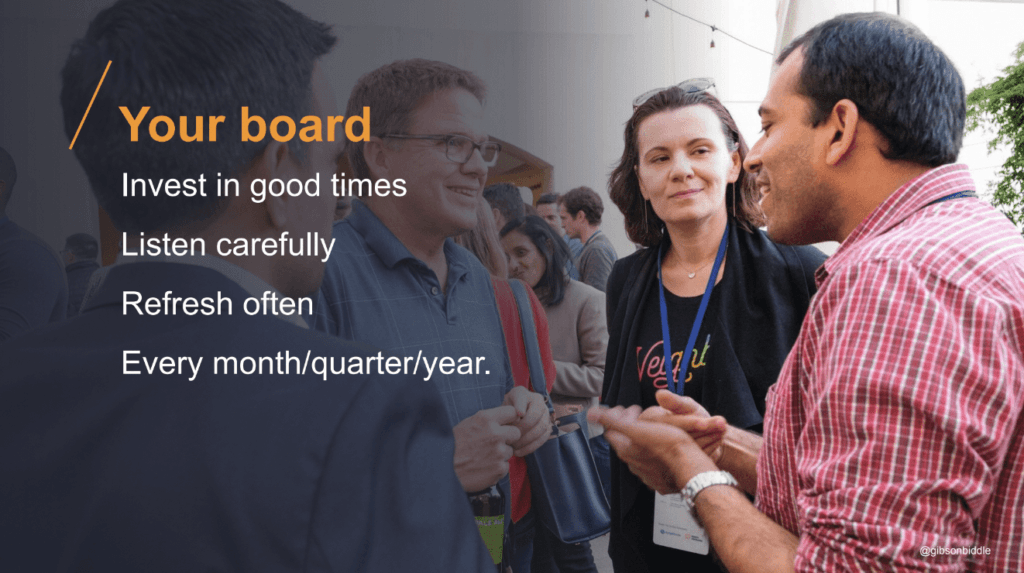
Peers! No excuse. You should be able to form relationships with your peers out there. It’s mainly because it’s all about past colleagues and LinkedIn has made this wicked easy. And then you’re looking for folks that are in similar roles, function, stage of company, where they’re going through different issues. You guys can just simply compare notes and provide mutual support to each other.
Now, the harder part of the equation is mentors. And probably, I don’t know, a third of my board is mentors and two-thirds are peers. If you asked 10 people to be your mentor, maybe one or two will work out, but you’re looking for folks with extraordinary judgment. They have broad skills and network, and this wonderful combination of being candid because they care about you. That’s why you need real relationships.
People will ask me what I think like, should I go to business school? I’m like, I don’t know. I don’t know you. It takes a lot of context-setting to be truly helpful, and then to dare to be candid. To deliver the real truth in a caring way.
Some tips on finding mentors. My very first tip is please do not ask someone to be your mentor. It’s a very awkward conversation. That’s not really how it begins. It starts with strengthening a weak link. So you notice Irv Grossback, went to Amherst College. That’s an example of a weak link.
Or this is John Liu. John Liu was in data science at Nerd Wallet. I was the three-day week Product Leader there. He came to me, we started talking, I realized I liked him. We liked each other. It was a personality fit.
And then I give little tests to folks and a simple test is, Hey, John set up lunch five weeks from now. I’m really seeing if he cares enough to navigate my challenging schedule. And he did. And then the tricky part is, how do you create value for mentors?
News flash. I’m 58 years old. I need help from 20 and 30-year-olds to stay relevant. Right? Help me understand TikTok. Or why would someone on YouTube slow down their video by 20% or speed it up? Help me out. Or help me understand why a Prius is bougie. Because I thought only Teslas were bougie. So my point is everybody needs some help. Even mentors.
In the case of John, John was like, Gib, I want to go into product. Do you have a startup I could work with on the side? I had nothing for him. He was frustrated. I was frustrated. Finally I said, John, just fricking go off and build me a website. He said, I can’t do that. So I gave him my credit card and said, go to Squarespace. I know you can do it. And on Monday morning, he showed me what I still refer to as my baby website, at gibsonbiddle.com. He created value for me. And because of this, we have ongoing relationship.
So I hope I’ve communicated to you how important it is to build that personal board of directors. It’s probably the easiest thing that you can start doing tomorrow. The other things require a little deeper thinking a little bit more time.
I’m going to bring it home for you. Here’s the question. What would you do if you weren’t afraid? Because it’s my belief that it’s fear that’s holding us back. It’s fear that keeps us from contemplating change. It’s fear that keeps us from making that occasionally bold bet on ourselves.

If you’re one of those folks, the 40% in the zero to six category, you need to take some sort of action. If you’re in the seven or eight, you know, your career could be better. And I’m delighted for the nines and tens, keep doing stuff.
The action that I encourage you to take is all about the principles I’ve been talking about in hacking your career. I’d love you to think about how do you position yourself? What are your product and leadership superpowers? Reflect on that career ladder, where you are, and the new skills that you want to develop.
Based on that, form hypotheses. Begin to find ways to experiment with side projects. Read a book, take a course, engage with a startup on a Saturday. Whatever it takes.
Then you need a way to evaluate what’s working and not. And because we’re humans, it’s easier if we talk and work with others. That’s why I’d love for you to get feedback via your personal board of directors. And this is what career hacking is all about. This continues forever until you’re older than dirt like me.
At the end of the day, I want everyone out there to have job satisfaction of eight, nine, or a 10. And it’s doable if you take some of these ideas to heart. So with that, I want to say thank you, thank you very much for being with me today. It’s been great fun.
